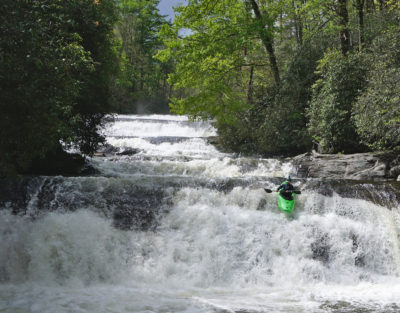Paddling 101
| June 7, 2019
A paddling trip is one of the best ways to get outside, but paddling does include some inherent risks. The danger is greater on more challenging rapids, but even on flat water, unexpected obstacles like downed trees can put boaters in precarious situations. Proper knowledge and safety precautions will help to minimize these risks. Here are a few tips to get you started:
- Always wear a personal floatation device, also known as a PFD, when you are on the water. Many drownings occur in relatively easy water, so don’t assume a life jacket isn’t necessary for calmer trips. Many PFD options exist, from inflatable belts for stand up paddle boarding on easier water to high-float rescue vests for harder whitewater. Choose a PFD appropriate for your activity and skill, and don’t use a rescue vest unless you have received proper training.
- Take a swiftwater rescue course. These courses aren’t just for rescue professionals. Anyone who paddles on rivers can benefit from the knowledge and skills taught in these courses. Once you have taken a course, always take a throw bag on river trips. Throw bags are self-contained ropes specifically designed for use on the river while rescuing swimmers or recovering a lost boat.
- Gather information about your paddling destination before you go. Determine whether a stretch of river is appropriate for you by considering the water level, river gradient, rapid classification, and weather. Remember that heavy rain and high flow can make any river or creek significantly more dangerous. Know where you plan to put on and take off the river or lake. Have an alternate plan for getting off the river or lake if you can’t make it to your planned take out due to an accident, change in weather, or other unforeseen circumstance. American Whitewater offers a comprehensive online database of popular river stretches around the country. Many areas also have local website or guidebooks with additional information.
- Understand the classification system for whitewater. While no substitute for detailed river information, these rapid classifications provide a general sense of a river’s difficulty. Class I is easy water with light riffles and only obvious obstructions like bridges. Class II is moderate; rapids require intermediate maneuvering skills but generally have clear passages between rocks. Class III rapids are moderately difficult, with higher and more irregular waves, and should be scouted beforehand. Class IV rapids are difficult and powerful, often with unavoidable hydraulics. Class V is extremely difficult, with long stretches of violent rapids, large obstructions and steep gradient.
- Be prepared. Make sure you have proper equipment. At a minimum, this means non-slip shoes or booties, a PFD, synthetic or wool clothing and drinking water. Purchase your equipment from a reputable manufacturer or retailer; this will ensure that your equipment fits properly and is well-designed for its intended use. A helmet is never a bad idea on any moving water, and is a must for anyone in a decked kayak or anyone running harder or shallower whitewater.
- Get instruction and find a mentor. The Southeast is full of reputable outfitters and instructors who can provide anything from basic safety instruction to advanced whitewater instructions. Even if you only plan to paddle flatwater, you can still benefit from instruction. If you plan to paddle regularly and want to advance, find a paddling mentor. Paddling is a group activity and you can learn a lot from your fellow boaters.
Related Articles
Latest News
More Stories

Leave a comment
Your email address will not be published. Required fields are marked *






Leave a Comment